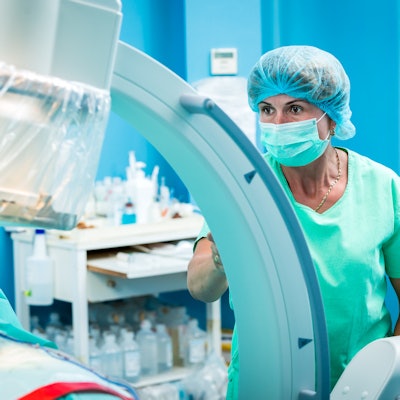
Over the past decade, continued advances in fixed C-arm technology and other clinical innovations in interventional radiology have been shaping how fixed C-arms are used. As a result, the distinction between the traditional cardiac catheterization lab and the interventional radiology (IR) has become blurred.
C-arms can be installed in radiology-related departments (e.g., radiology, interventional radiology, special procedures, and angiography labs) and cardiology-related departments (e.g., catheterization labs; cardiology, cardiovascular, vascular, and endovascular departments; and electrophysiology labs), as well as in surgery-related departments (e.g., hybrid operating rooms and surgery departments), with multiple physician specialties having access to the labs.
 Lorna Young of IMV Medical Information Division.
Lorna Young of IMV Medical Information Division.Interventional procedures, which were once the exclusive domain of interventional radiologists before they were embraced by cardiologists, are now being adopted by surgeons as an essential tool for minimally invasive surgery.
Department leaders in all three of the department types that currently employ fixed C-arms all share optimism that procedures conducted on their fixed C-arms are growing, with 75% of the respondents in a new IMV survey indicating that a top priority for their department is to manage increased procedure volume on their fixed C-arms (ratings of 6 and 7 on a seven-point scale).
Typically, regardless of the department in which fixed C-arms are located, a variety of physician specialties utilize the fixed C-arms, and satisfying "the needs of the surgeons and interventional physicians who use the fixed C-arms" is a top priority for all the department administrators.
The top two physician types currently performing procedures using fixed C-arms, regardless of the department, are interventional radiologists (74% of sites) and interventional cardiologists (67%), followed by vascular/endovascular surgeons, electrophysiologists, and cardiac/cardiovascular surgeons, each involved in about one-third of the sites.
The top use of fixed C-arms in all three department types is to perform diagnostic and therapeutic interventional procedures, but their use for other clinical purposes differs significantly by department type, which results in different needs for equipment capabilities and workflow. Not surprisingly, surgery-related departments are more likely to be conducting open surgery and other hybrid procedures using their fixed C-arms, while cardiology-related departments are more likely to be performing angioplasty/percutaneous coronary interventional (PCI) procedures.
The trend toward increased use of fixed C-arms for minimally invasive procedures is bright, as 41% of respondents in the IMV survey gave high ratings (score of 6 or 7) for the opinion statement "more minimally invasive procedures will be performed using fixed C-arms over the next two to three years, shifting away from open surgery procedures," resulting in an overall average score of 5.0. Surgery-related respondents are more optimistic about this trend, giving a significantly higher average score of 5.5, compared with radiology- and cardiology-related respondents (4.9).
In surgery-related departments, the current mix of fixed C-arms is still in the early adopter stage. IMV estimates that surgery departments comprise 8% of the hospital departments having fixed C-arms, but have only 6% of the fixed C-arm units.
Going forward, purchase plans show that 58% of the surveyed sites are "yes" planning or "maybe" planning to acquire new systems in 2019-2022, with 27% of the planned units being planned for surgery-related departments that will primarily be first-time placements, whereas for radiology- and cardiology-related departments, replacement will be a key purchase driver.
However, certain market inhibitors may influence the actual purchase rate for C-arms, with the top issue limiting the ability of hospitals to offer minimally invasive procedures being the "need to increase the numbers and types of specialty physicians skilled to perform such procedures." Not surprisingly, radiology-related respondents to the IMV survey were more likely to be seeking to attract or retain interventional radiologists, while cardiology-related respondents were primarily seeking interventional cardiologists, and the surgery-related departments were seeking vascular/endovascular and other types of surgeons.
For surgery-related departments, additional issues include the "need to renovate and/or expand their physical space/facility" and having state-of-the-art C-arm technology, clinical applications, visualization software, and improved scanning/imaging protocols as key needs.
As minimally invasive surgery is an image-guided treatment procedure, an interdisciplinary team approach is often sought to improve outcomes, with the cardiology/surgery respondents significantly more likely to seek to strengthen the way interdisciplinary teams work together. As one IMV survey respondent stated, "the collaborative approach opens new perspectives for patient treatment leading to better outcomes."
The use of fixed C-arm technology is increasing in surgery-related departments, but portable/mobile C-arms continue to be an important tool, particularly for image guidance to perform open surgery. Virtually all the hospitals with fixed C-arms reported they use portable/mobile C-arm units in the surgery/operating room department. Orthopedic and general surgeons are most likely to be using portable C-arms at 80% or more of the hospitals, followed by vascular/endovascular surgeons, gastrointestinal physicians, and neurosurgeons.
Lorna Young is the senior director of market research at IMV Medical Information Division in Des Plaines, IL.
IMV's "2019 Fixed C-arm Market Outlook Report" explores trends in the use of fixed C-arm systems in radiology, cardiology, and surgery-related departments in U.S. hospitals. The report chapters cover respondent opinions on their department priorities and their future outlook, estimates for patient case volume and procedure mix, the installed base of fixed C-arms by department type, replacement cycles, purchase plans for fixed C-arms, and manufacturer installed base share and brand loyalty. In addition, the report covers the relative size of the installed base and purchase plans for portable/fixed C-arms and compares the physician types routinely using fixed versus portable C-arms by department type. Manufacturers covered in this report include Canon, GE Healthcare, Hologic, OrthoScan, Philips Healthcare, Shimadzu, Siemens Healthineers, and Ziehm.
The report is based on survey responses to an IMV-hosted online survey of conducted from March to April 2019 with over 190 radiology, cardiology, and surgery/hybrid operating room department leaders in U.S. short-term general hospitals who provided information regarding over 390 departments having or planning to acquire fixed C-arms at their facilities. Key statistics from the survey have been projected to the IMV-identified universe of more than 2,950 hospitals that have at least one fixed C-arm system installed in over 5,300 radiology, cardiology, and surgery-related departments in those hospitals.
For information about purchasing IMV's "2019 Fixed C-arm Market Outlook Report," visit the corporate website at www.imvinfo.com or call 773-778-3080 to speak with a representative.
Disclosure notice: IMV Medical Information Division is a sister company of AuntMinnie.com.



















